 When you little scamps get together you're worse than a sewing circle. 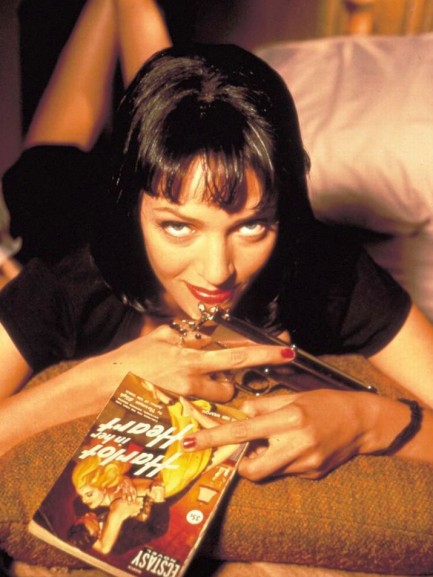
Sex was her weapon! The line isn't about Uma Thurman. It comes from the cover of Harlot in Her Heart, the Norman Bligh novel she's holding in this promo shot made for her 1994 blockbuster hit Pulp Fiction. An interesting factoid about the movie is that it lost the Academy Award for best picture to a slice of saccharine nothingness called Forrest Gump thanks to a pathologically risk averse voter pool. It's an embarrasing miss for the Academy, because Pulp Fiction ranks as one of the most influential American movies ever. It took the disordered narrative structure that had been established in earlier films and elevated it to a new level. It borrowed the box-of-mystery gimmick that had already been turned on its head in movies like Kiss Me, Deadly and Belle du jour, and turned it on its head again. It incorporated a hip, ethnically mixed cast. It was funny as hell. And it placed Thurman at the center of its hyper-masculine narrative as the femme fatale Mia Wallace—who dug criminals, was tough-minded, graceful, impulsive, and smart. Her line about men being gossipy scamps was one of the best in the film. We can't imagine anyone else playing the role. As for Harlot in Her Heart, we may just buy it despite its exorbitant price. If so we reserve the right to use the cover again in a later post. 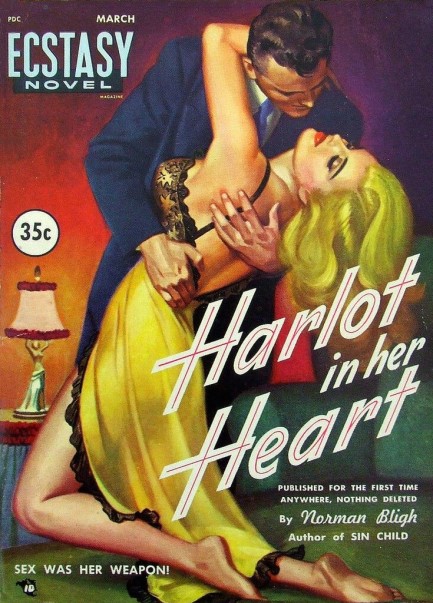
 We're still at it because like all PIs we're persistent. 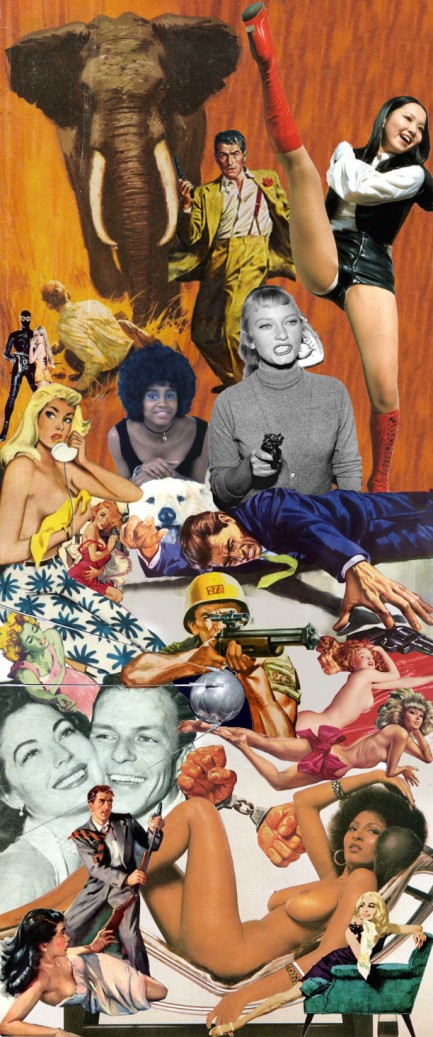
So we've been doing Pulp Intl. for twelve full years, as of today. That's a lot of trainspotting. Sometimes we're asked why there's so little information about us on the site. To us, there's too much, but we're flattered anyone would care. We can put a little info out there. We're nobodies. See? That was easy. We've also had people ask us to explain exactly what the site is about. Okay, what we're trying to do is create a conversation about art, literature, and cinema, and how they're perceived culturally, but especially temporally, while also mixing in real world material mirroring the focus of those media, which is why we examine feminine beauty, vintage tabloids, and old crimes. We're trying to do all that while using the actual art as a launching point and being light in tone when we discuss it. First the art, then the work it promotes, then the implications of the art and the work.
One aspect of these musings involves the influence of the profit motive on media. Seeking ever larger payouts, publishers and movie studios have jettisoned virtuosic promo illustrations created by artistic masters in favor of art designed in computer programs, nearly all of it within the capabilities of any graphic design graduate. The arc is interesting to observe. At the beginning of the mass media era beautiful art was not a priority for publishers and studios. Both realms experienced a peak in design that paralleled the rising popularity of their products, followed by a dramatic fall-off in artistic quality even though their products remained popular. So with Pulp, in addition to discussing the merits of film and literature, we like to look at how promo art developed, improved, then degraded over time.
Another area we're interested in is sex in media. Depictions of sex—the single most important thing humans ever do—have almost vanished from popular media. We think this happened due to fear, guilt, the influence of a minority of puritanical reactionaries, and the politicization of even loving and joyful depictions of sex. Yet the ongoing banishment of sex hasn't benefitted society, but instead has given an innovative pornography sector outsize influence over ideas of what constitutes normal forms of sex. We sometimes imagine future alien archaeologists, thousands of years from now, sifting through the rubble of U.S. civilization. Like earthly archaeologists they would look for clues who their subjects were in their art, and when they discerned that violence and death were viewed as entertainment but the procreative act was seen as shameful, they'd reach the conclusion that there was something seriously wrong with the creatures they were studying. So with Pulp, we like to ponder whether the loss of sex from popular media is a step forward or a step backward.
Why are we qualified to ask all these questions? We're not. But we've been well schooled, well careered, and have seen and done a lot. We've been, either separately or collectively: screenwriters, magazine editors, musicians, workers in the porn industry (behind the camera), Hollywood insiders, social outsiders, bar owners, heavy drinkers, heavy drug users, global travelers, longtime residents of lands far flung from the Colorado where we spent our youth, and sources of consternation for many. And there are only two of us that do this site, so that's a lot of experiential ground covered in a number of years that would surprise you in their brevity. We're not experts about anything related to pulp, and the only credentials we have consist of Pulp Intl. itself. We use this website to learn as we go, and our visitorship from you guys makes the process fun.
Right now, twelve years in, Pulp. Intl. is doing fine. But we still haven't gotten the site redesigned, and at this point we realize we never will. Little pieces of it stop working occasionally, due to changes in the architecture of the internet. We realize that one day, due to some glitch or obsolescence, the entire site will go offline. We'll wake up and it'll be inaccessible, and that will be that. But we're going proceed as if Pulp Intl. will last forever. And if that moment comes when the site vanishes and doesn't reappear within a few days, it won't be because we just quit. It'll be because rebuilding it was too hard. On the other hand, maybe instead of trying to do it ourselves we'll finally pay somebody to bring it all up to spec so it'll run smoothly. There's that option too. We'll see. Thanks for your visits, and please keep coming back.
 Just let me out! I know a little about cars and I don't think that's what four-on-the-floor really is. 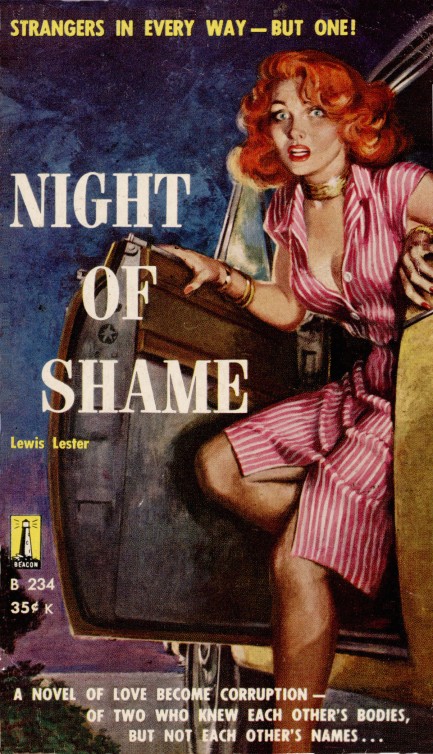
Four-on-the-floor. Too easy, right? What can we do? We're only human. 1959's Night of Shame deals with anonymous partners in a one night stand whose lives are complicated by their constant desire for each other. Later, they meet again by chance and rekindle their affair, only to discover, as Mr. Spock once so eloquently put it, that having is not so pleasing a thing after all as wanting. The beautiful cover on this is unattributed, but it could be Rudy Nappi. We reached that conclusion because it's very similar stylistically to this cover, which is identified as Nappi's work in Gary Lovisi's Dames, Dolls and Delinquents: A Collector's Guide to Sexy Pulp Fiction. Problem is, we don't actually think that cover is Nappi either. We think it's Howell Dodd. This wouldn't be the first time we've doubted Lovisi, but what do we know? We didn't write a whole book on the subject. So, okay, call this one Nappi.* *psst—it's Dodd.
 You're finally here. Your apartment's on fire. Someone threw matches in the window. Someone who doesn't like waiting I bet. 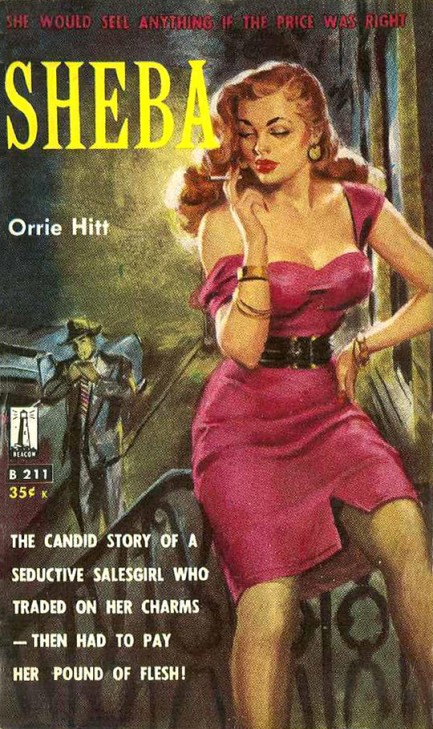
Whenever we see this sort of distinctively sculpted red hair on a cover femme fatale we think the artist is Howell Dodd, but Gary Lovisi's Dames, Dolls and Delinquents: A Collector's Guide to Sexy Pulp Fiction says this is actually Rudy Nappi's work on the front of Orrie Hitt's Sheba. Nappi did his share of sculpturally coifed redheads, so Lovisi is probably right. The cover banner says Sheba Irons would sell anything, which might be true, but her actual job, once she secures it, is to sell cars. She and the other employees at the dealership sucker customers into unscrupulous financing deals, but this is Hitt fiction, which means the details of the business are minimal—the recipe here is sex and scandal. The men at the dealership all want Sheba, and when they eventually find leverage they seek revenge for having been rejected. We've seen this called one of Hitt's worst books, but anyone who would say that really doesn't know Hitt. There's no worst—they're all bad. This one is solidly middle-of-the-road for him.
 She can be either or both depending on her mood. 
Here's another nice shot of b-movie actress Nadia Cassini, who we last saw back in 2010. Cassini, who in our view is one of the better products from low budget cinema, was born in the U.S., but worked mostly in Europe, appearing in such films as Pulp, Il dio Serpente, and Starcrash, the latter of which we'll definitely write about soon, since it's one of our favorite bad movies ever. But don't blame Cassini—she was absolutely fine in it. And she's absolutely fine here too. This image first appeared in the magazine Oui in 1972.
 The stuff that bad dreams are made of. 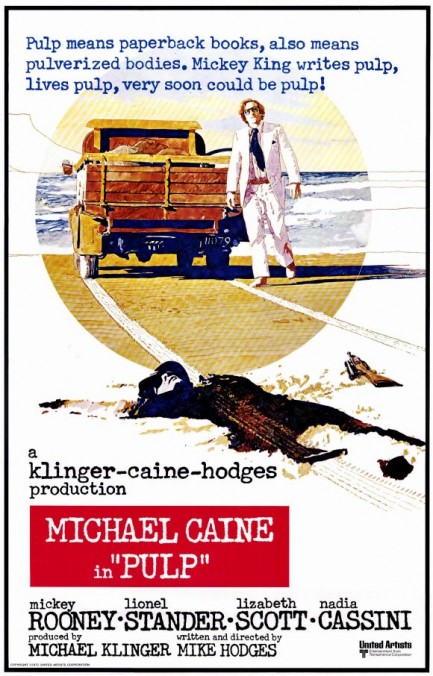
Any movie called Pulp is one we must watch, and since Mike Hodges of Get Carter fame helmed the production we were confident going in, especially since we knew it featured bombshell Nadia Cassini and numerous locations in some of the prettiest and most remote parts of Malta. In fact, as a travel piece the film is flawless (Hodges could have written it for the sole purpose of getting a Mediterranean vacation on the Hollywood dime), but as satire, it’s torturous, despite a few clever sight gags and four or five sharp one-liners. Don’t get us wrong—there are merits: always-interesting star Michael Caine, character actor Lionel Stander, and Hollywood icon Mickey Rooney. But there was also a lot of bad: star Michael Caine sleepwalking through the production in owl glasses and a pompadour, character actor Lionel Stander in a cock-hugging one-piece bathing suit, and Hollywood icon Mickey Rooney getting his dangle on in size forty tightie-whities. To quote our girlfriends, “Eew.” Yes, we know they’re riffing on their own tough-guy images. But still, eew. The main problem with this movie is there’s simply no—if you’ll excuse the term—thrust to the plot. Even satire needs to go somewhere, otherwise it's just middle-aged men showing their packages for nothing. If Rooney and Stander ever watched Pulp without cringing they did better than us. However, since scantily-clad men are rare in the macho world of pulp, we’ve posted some beefcake as a treat, below. And afterwards, we have some shots of Malta that’ll really turn you on. Pulp opened in the U.S. this week in 1972.
    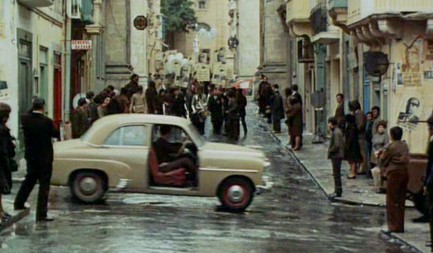   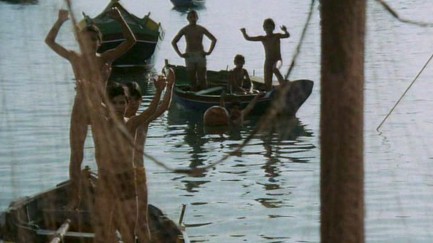   
 Tamil pulp hits foreign shores this week. 
Chennai, India-based Blaft Publications has followed up their acclaimed 2008 collection of Tamil pulp stories with a second volume, which they’ve called Tamil Pulp Fiction II. Original, untranslated copies of Pulp II have been available since April, but the first English copies are just hitting American bookstores this week. We haven’t read any of the stories, but we’re aware of how popular the genre is. In India, pulp paperbacks are sold at every newsstand in the country, along with the incredibly popular crime magazine Murder Weekly. Indian crime writers in general are becoming more recognized worldwide, led by Aravind Adiga, who won the Man Booker Prize in 2008 for his novel The White Tiger. You can learn more about Tamil Pulp Fiction II and read an excerpt at NPR, here.
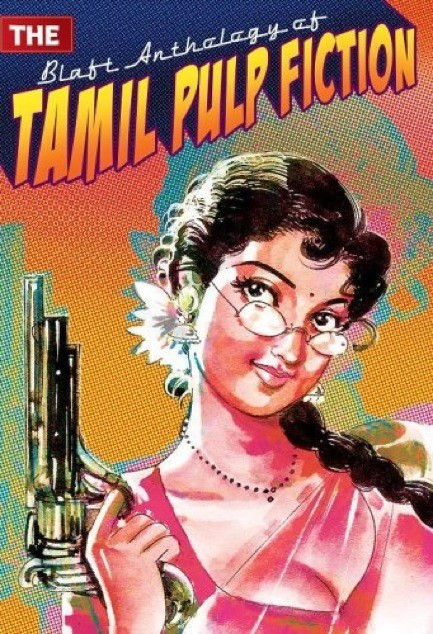
|
 |

The headlines that mattered yesteryear.
2003—Hope Dies
Film legend Bob Hope dies of pneumonia two months after celebrating his 100th birthday. 1945—Churchill Given the Sack
In spite of admiring Winston Churchill as a great wartime leader, Britons elect
Clement Attlee the nation's new prime minister in a sweeping victory for the Labour Party over the Conservatives. 1952—Evita Peron Dies
Eva Duarte de Peron, aka Evita, wife of the president of the Argentine Republic, dies from cancer at age 33. Evita had brought the working classes into a position of political power never witnessed before, but was hated by the nation's powerful military class. She is lain to rest in Milan, Italy in a secret grave under a nun's name, but is eventually returned to Argentina for reburial beside her husband in 1974. 1943—Mussolini Calls It Quits
Italian dictator Benito Mussolini steps down as head of the armed forces and the government. It soon becomes clear that Il Duce did not relinquish power voluntarily, but was forced to resign after former Fascist colleagues turned against him. He is later installed by Germany as leader of the Italian Social Republic in the north of the country, but is killed by partisans in 1945.
|

|
|

It's easy. We have an uploader that makes it a snap. Use it to submit your art, text, header, and subhead. Your post can be funny, serious, or anything in between, as long as it's vintage pulp. You'll get a byline and experience the fleeting pride of free authorship. We'll edit your post for typos, but the rest is up to you. Click here to give us your best shot.

|
|































































































